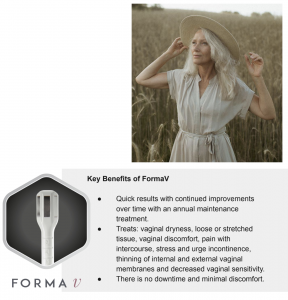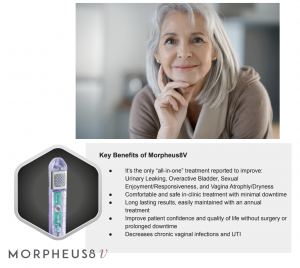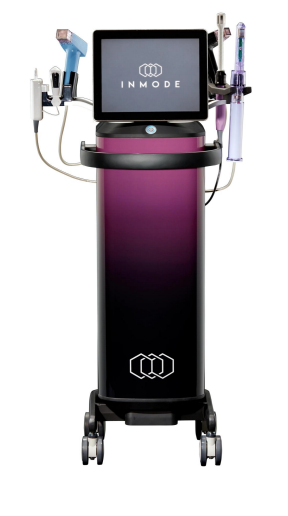Life changing treatments are now available for incontinence, intimacy issues and menopausal symptoms.
Incontinence and GSM of menopause are NOT a normal part a women’s life and are not something you should have to live with. Inconteninence and GSM are real medical conditions that deserve treatment.
TREATMENTS AVAILABLE
V Tone
- Up to 6 treatments
- 1-3 weekly depending on response
Forma V
- 2-3 sessions
- 2-4 weekly, depending on response
- Maintenance: may need single treatment every 3-12 months with gradually increasing spacing
- 2-3 treatments
- 3-4 weekly
- Maintenance: may need single treatment every 3-12 months with gradually increasing spacing
Do you suffer from?
- Vaginal Dryness (Vaginal Atrophy)
- Stress Urinary Incontinence (SUI)
- Urge Incontinence or Leaking
- Overactive Bladder or Urinary Frequency
- Interrupted Sleep from Multiple Trips to the Bathroom
- Painful Intercourse or Sexual Dysfunction
- Chronic or Recurrent UTI
- Recurrent Vaginal Infections (Yeast or Bacterial)
- Lichen Sclerosis
- Vaginal Laxity or Reduced Elasticity
- Pelvic Floor Weakness
- Decreased Vaginal Sensation or Decreased Ability to Achieve Orgasm
- Vulvar or Vaginal Pain
- Episiotomy Pain
- Labial Laxity, Redundant or Crepey Vulvar Skin or Labia
- Displeasure or Lack of Confidence in Vaginal/Vulvar Appearance
- Burning or Itching with Menopause
Did you check even one of the above?
If so, then you could be a candidate for Emsella or Empower RF treatments which are safe and effective. This innovative technology can make significant improvements and a real difference to your quality of life. This treatment is available at Natural Looks Cosmetic Medicine Clinic, book an appointment for an assessment and plan to get started.

The innovative Empower RF device offers seven different treatment options allowing us to find the right treatment combination for you. This treatment is safe and effective for all stages of life. EmpowerRF delivers life-changing technologies for women’s wellness – treating a broad range of conditions such as urinary incontinence, vaginal dryness and pain, weak pelvic floor muscles, decreased sensation and so much more.
This innovative technology uses a combination of radiofrequency (RF) and electrical muscle stimulation (EMS) to help you regain your self-confidence and improve your quality of life. Women with any of the following; vaginal dryness, pain with intercourse, stress urinary incontinence, overactive bladder, vaginal laxity, chronic vaginal infections, or lichen sclerosis will benefit from this treatment. It is suitable for aesthetic enhancement, rejuvenating sagging or crepey skin and providing more youthful, better-toned tissue, which can result in a boost in sensation with intercourse. Studies have shown that women can experience an increase in sexual drive and response.
At Natural Looks Cosmetic Clinic, we understand your concerns and have the available treatments to benefit women’s health focusing on incontinence and intimacy issues. We offer treatment packages and medical consultations with our doctor to diagnose your condition and advise on the most effective treatment option for you.

VTone utilises electromagnetic energy which stimulates thousands of supramaximal muscle contractions that re-educate the pelvic floor muscles.
VTONE can reduce all types of urinary incontinence including stress, urge, mixed, overflow and function incontinence. Urinary incontinence is very common among women (1 in 3) and can be triggered by pregnancy, childbirth, perimenopausal and menopause.
The treatment tightens vaginal tissues, strengthens kegel muscles, restores vaginal muscle tone, increases vaginal sensitivity, reduces urinary concerns, improves sexual pleasure and improves the appearance of lax opening after childbirth.
VTone is a painless treatment that requires no anesthesia. It has no downtime or recovery period and uses no injections or incisions. This gentle, effective treatment series rehabilitates a woman’s pelvic floor to improve the overall quality of life.

FormaV is a safe and effective treatment option to help resolve complaints like dryness, itching, laxity and urinary incontinence. FormaV delivers radiofrequency energy into the tissue with a gentle sweeping motion throughout the vagina and vulva, The procedure safely and effectively heats the tissue which stimulates fibroblast activity and new blood vessel formation which improves blood flow, collagen and elastin throughout the treated area.
FormaV markedly relieves irritating vaginal and vulvar dryness and reduces painful intercourse. The increased collagen elastin provides better support to the bladder and urethra which helps relieve stress urinary incontinence. This increase in tissue strength also improves the overall appearance of the vagina and vulva after childbirth and with aging. By reducing vaginal laxity, the sensation is improved which results in greater enjoyment of intercourse and easier orgasms. Rejuvenation of the surface tissue of the vaginal canal restores the normal vaginal pH, which decreases the risk of chronic UTI’s and recurrent bacterial and yeast infections. With all these improvements, FormaV has high patient satisfaction.
There is minimal preparation and downtime for FormaV and the treatment differs per patient. Patient plans include various combinations of the EmpowerRF platform. Our doctors will provide a customised plan that targets your specific issues.

Morpheus 8V is the latest fractional radiofrequency device to address women’s health issues and is providing outcomes not achieved before with a single device.
The device delivers pulses of energy deep into the vaginal and vulval tissue at 1, 2 and 3 mm depths. The heat stimulates the fibroblasts producing an increase in collagen and elastin, which increases the strength and thickness of the vaginal tissue. This provides more support, lubrication and elasticity of the vagina and vulva.
Morpheus 8V is excellent for treating stress and urge incontinence, making it the first device that can markedly improve the symptoms of mixed incontinence. Studies performed in conjunction with doctors around the world, show benefits for more than 90% of treated women.
Morpheus 8V can be paired with FormaV or Vtone to optimise your outcome as well as creams to accelerate healing. Our Doctors will assess your suitability and help you choose the custom regimen that fits your needs.
MORPHEUS8 CASE STUDY
Safety, Tolerability and Short-Term Efficacy of Transvaginal Fractional Bipolar Radiofrequency Therapy for Symptoms of Stress and or Mixed Incontinence in conjunction with Genitourinary Syndrome of Menopause Tracy A. Blusewicz, MD, (FACOG), Katherine P. Coley, MD, (FACOG), Mickey Karram, MD, (FPMRS)
Introduction: Radiofrequency energy has been utilized to treat conditions such as vaginal laxity, atrophy, and stress urinary incontinence (SUI). Contact RF energy heats the mucosal surface of the vagina uniformly to deliver electrothermal energy to the connective tissues in the vaginal wall. This RF energy application stimulates collagen and elastin remodeling to restore the rigidity, elasticity, and moisture of the superficial vaginal mucosa. The limitation of this surface treatment is in the penetration depth of the energy to the vaginal tissue layers. This is the first study to report on the use of microneedling to deliver RF energy to the vaginal canal similar to what has been used to treat the skin surface of the face, neck, and chest. Microneedling increases the response of the collagen contraction and neocollagenesis in deeper layers of tissue, thus increasing the support to the surface. The novel intravaginal microneedling device used in this study allows penetration of the needles to 1 mm, 2 mm, or 3 mm.
Objective: A prospective pilot study to evaluate the outcome of a single fractional RF treatment of the vaginal canal in a series of women with coexistent stress or mixed incontinence (MUI) and genitourinary syndrome of menopause (GSM).
Methods: Twenty women who had symptoms of SUI and or MUI in conjunction with GSM were given a single vaginal treatment that consisted of fractional bipolar RF energy using the EmpowerRF platform with the Morpheus 8V applicator (InMode). RF energy was delivered into the vaginal walls via 24 microneedles, at a depth of 1 mm, 2 mm, and 3 mm. Outcomes were evaluated by “cough” stress test, questionnaires (MESA SI, MESA UI, iQoL, UDI-6) and evaluation of vaginal tissue through the VHI scale at 1-month, 3-months, and 6-months post-treatment compared to baseline. Biopsies were performed at baseline and 3-months on 5 patients for histological reference and tissue evaluation.
Results: Eight out of eight outcomes measured from baseline to 6-months post-treatment showed improvement. The parameters scored in the questionnaires including frequency,urgency, nocturia, urge incontinence, and stress incontinence showed significant improvement in all areas at the 1-month, 3-month, and 6-month follow-up sessions compared to baseline.
Conclusions: The results showed significant evidence that fractional RF energy delivered vaginally is safe, well tolerated, and helps treat symptoms of SUI and or MUI in conjunction with GSM.
Histological Results
Histological biopsies of the vaginal mucosa at 3- months post-treatment demonstrate an increase in elastic fibers density compared to the baseline biopsy. Both superficial and deep elastic fibers are seen. The biopsies also find nodamage to the submucosal collagen layer and no scar tissue formation in post-treatment, verifying no adverse effect of the fractional RF treatment.Figure 2 shows biopsies performed prior to treatment and at 3-months post treatment stained with elastic and Ki-67 stains.

Figure 2. Histological section of skin biopsies before (Left) and 3-months following fractional treatment (Right) demonstrating increase in elastic fibers density. Up – Elastic x10, bottom – Ki-67×4.
BEFORE TREATMENT
You’ll come in for a confidential consultation with one of our vaginal rejuvenation experts to assess the symptoms you’re experiencing and develop a customised plan to improve your intimacy, bladder control and additional vaginal concerns. Specific instructions will be provided at your initial appointment. Treatments with FormaV and Morpheus 8V require the pubic area to be shaved 2-3 days before each procedure.
DAY OF TREATMENT
Most treatments need very little preparation, have no downtime, and can be performed on the same day. For each treatment, allow
approximately 45 minutes for VTone, 40 minutes for FormaV, 40 minutes for Morpheus 8V and 30 minutes for Emsella is recommended. Topical anaesthetic is applied for some treatments to make the process completely comfortable. It’s safe for you to drive yourself to and from all of your treatments.
AFTER TREATMENT
There are very few or no restrictions for most EmpowerRF treatments. With Morepheus8V we recommend avoiding intercourse, pelvic exams, and tampons for 2-3 days and keep the area moist with recommended products provided at your visit. Most patients will note results after the first treatment and continued improvement after the complete series of treatments. To maintain optimal results, annual maintenance treatments are highly recommended.
“I AM PASSIONATE ABOUT ADVOCATING FOR ALL ASPECTS OF WOMEN’S GYNAECOLOGICAL HEALTH AND REDUCING STIGMA AND BARRIERS TO ACCESSING TREATMENT.”
Dr Judy Craig

Medical Director and Founder, Natural Looks
Women’s health, and gynaecological health in particular, has historically been neglected. I am passionate about advocating for all aspects of women’s gynecological health and reducing stigma and barriers to accessing treatment.
Offering safe, effective solutions for issues where there were few effective
safe alternative treatments is very rewarding for me as a doctor. The EmpowerRF platform provides an opportunity to raise these topics in a non-threatening and supportive environment. EmpowerRF can address many issues, such as stress, urge and mixed incontinence, genitourinary syndrome of menopause, vaginal relaxation syndrome, vulvovaginal atrophy, lichen sclerosis and bacterial vaginosis. It also provides a non-surgical option for labiaplasty and can tighten and contract the labia minora, tighten the introitus and rejuvenate the labia majora.
What impresses you most about EmpowerRF?
Since introducing the treatment in my clinic, the results have been impressive, and it is rewarding to be able to offer women a treatment that can so significantly impact their quality of life. The innovative EmpowerRF is the only platform that offers seven treatment options to address women’s health issues. These can be adapted to achieve the best results for the patient My favorite combination treatment is FormaV. Morpheus 8V and VTone.
Formav is an RF- based treatment that heats the connective tissue of the vaginal wall, triggering a micro inflammatory activation of fibroblasts to stimulate neocollagenesis, neoelastosis, neovascularsation, proliferation of the glycogen-enriched epithelium and contraction of collagen to tighten, revitalise and restore strength, elasticity and moisture to the vaginal mucosa.
I follow this with Morpheus 8V, a ground-breaking microneedling treatment, for severe symptoms or when there is significant laxity. The goal tissue temperature is already achieved with the Forma V pre-treatment. enhancing the benefits of the Morpheus 8V. Tone then provides intravaginal electrical muscle stimulation.
Extrapolation from studies on other devices shows combining muscle stimulation with RF energy results in increased muscle volume over muscle stimulation alone. RF alone has been shown to increase muscle strength without direct electrical muscle stimulation.
How is EmpowerRF improving your patients’ quality of life?
I have had very positive feedback from my patients regarding the significant change in their quality of life, in addition to improvement or complete resolution of symptoms of incontinence. Many of these women have recounted how much the quality of their sex life has improved. They report an increase in libido and improvement in their sexual response and intensity of their orgasm as well as increased lubrication.
Improving incontinence alone significantly impacts people’s lives. Treatment has enabled my patients to return to work, recommence exercise and join their family on overseas holidays, which before previously seemed impossible.
The results we can achieve with EmpowerRF are nothing“I AM PASSIONATE ABOUT ADVOCATING FOR ALL ASPECTS OF WOMEN’S GYNAECOLOGICAL HEALTH AND REDUCING STIGMA AND BARRIERS TO ACCESSING TREATMENT.” – DR JUDY CRAIG
Dr Judy Craig
Medical Director and
Founder, Natural Looks





